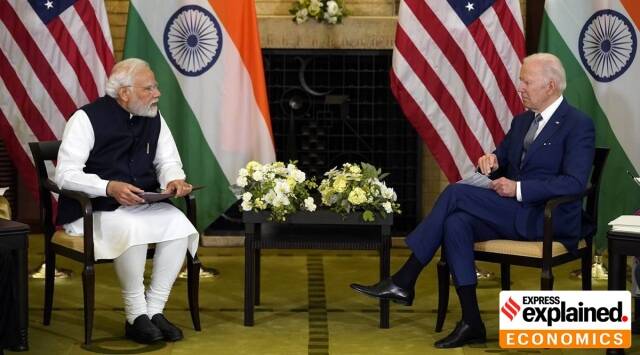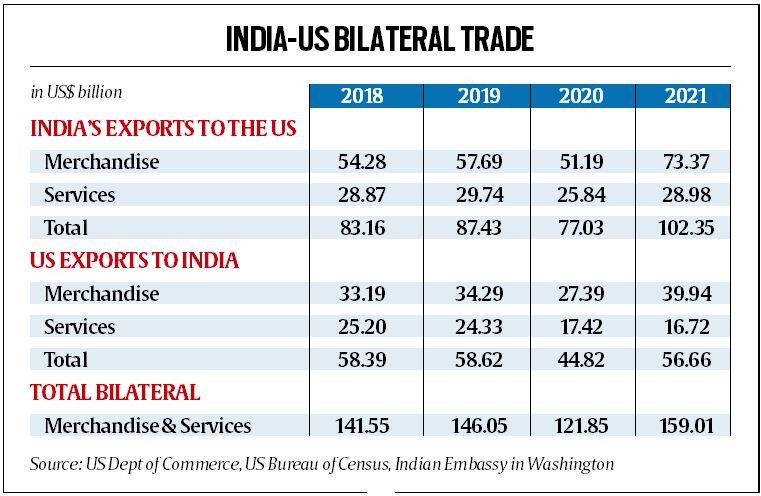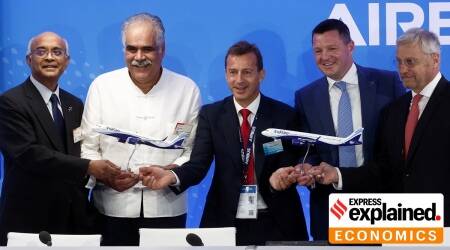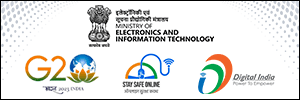At the heart of Indo-US ties: Economics and Strategy
Underpinning the Indo-US strategic partnership is deepening economic engagement and a resolve on both sides to elevate the bilateral relationship to a 'global strategic partnership'. Bilateral trade is at a record high and the potential is limitless — but there are some headwinds to contend with.
 US President Joe Biden and Prime Minister Narendra Modi.
US President Joe Biden and Prime Minister Narendra Modi. As Narendra Modi heads to the United States for an official state visit on the invitation of President Joe Biden, the bipartisan consensus in Washington on fostering the bilateral relationship is exemplified by the invitation extended to the Prime Minister by the leaders of the two chambers of the US Congress to address a joint meeting of Congress for a second time — an honour that has been accorded earlier only to a few leaders including Winston Churchill, Nelson Mandela, and Israel’s Prime Ministers Binyamin Netanyahu and Yitzhak Rabin.
Prime Minister Modi first addressed a joint meeting of Congress on June 8, 2016.
Economic engagement
At the heart of the Indo-US strategic partnership is deepening economic engagement and a resolve on both sides to elevate the bilateral relationship to a “global strategic partnership”. While the relationship is founded in shared democratic values and an increasing convergence of interests on regional and global issues, an indication of how far the needle has moved is in the fact that only 25 years ago, India was under US sanctions.
Modi’s visit comes at a time when the value of trade between the two countries has touched a record $191 billion, making the US India’s largest trading partner. For India, the favourable balance of trade position with the US is comforting, given that it has an adverse balance of trade equation with the majority of its other major trading partners. For the US, India is the ninth largest trading partner.

American companies have invested around $60 billion in India in sectors ranging from manufacturing to telecommunications and consumer goods to aerospace. And Indian companies have put in more than $40 billion in sectors such as IT, pharmaceuticals, and green energy, supporting, as Secretary of State Antony Blinken said in his address at the annual India Ideas Summit of the US-India Business Council (USIBC) on June 12, “425,000 jobs from California to Georgia”.
In February, Air India announced the purchase of more than 200 Boeing aircraft — a historic deal that President Biden said would “support over one million American jobs across 44 states”, and which will likely figure as a key pitch of his re-election campaign.
At the USIBC event, Blinken said Modi’s visit “will further solidify what President Biden has called a ‘defining relationship’ of the 21st century”.
Strategic underpinnings
Much of the relationship’s broader subtext is strategic, with both partners cranking up the engagement with an eye on China. Central to this cooperation is also the post-pandemic consensus on diversifying and deepening supply chains with trusted countries, while reducing strategic dependencies. The two governments are pursuing more than 50 bilateral dialogue mechanisms at various levels.
* The flagbearer of the strategic engagement is the Quadrilateral Security Dialogue. The Quad began as a broad partnership after the 2004 Indian Ocean tsunami, but gained strategic heft after the four-country grouping, which has Australia and Japan alongside India and the US, was repurposed in 2017, primarily as a counter to China’s growing influence in the Indian Ocean rim, and as a forum for redoubling focus on the Indo-Pacific region.
* The I2U2, a grouping of India, Israel, the US and the United Arab Emirates, is focused on joint investments and new initiatives in water, energy, transportation, space, health, and food security.
* This January, National Security Advisor Ajit Doval and his US counterpart Jake Sullivan launched a new US-India initiative on Critical and Emerging Technologies. During Secretary of Commerce Gina Raimondo’s visit in March, the two countries established a partnership to make the semiconductor supply chain more resilient through private sector cooperation. The semiconductor manufacturing agreement could have three main upsides for New Delhi.
The most important is the possibility of India getting aligned for a more central role in the global electronics supply chain — especially the possibility of potential convergence among the chip manufacturing incentive scheme launched by India and other governments around the world.
There is a commitment to mainstream India’s $10 billion incentives by dovetailing component manufacturing projects from established foreign chip firms and industry leaders, as opposed to just marginal players that have shown interest in India’s scheme so far.
There is also the possibility of India benefiting from a further realignment of the regional collaborative effort being fostered by the US, which aims to diversify the sourcing supply base for semiconductor chips and avoid duplication of efforts, government officials said.
The US is already pursuing the ‘Chip 4’ alliance initiative with three other top semiconductor makers, Taiwan, Japan, and South Korea. In September 2021, India, Japan, and Australia had announced plans to establish a semiconductor supply chain initiative “to secure access to semiconductors and their components”.
A convergence of regional efforts is possible if the US were to play a fostering role to avoid overlap of efforts by partner countries, with India being possibly drafted into some of the chip alliances that are currently under discussion.
* The defence sector is likely to see multiple pacts, building on the bilateral cooperation framework that is already in place. Cooperation in areas such as armoured vehicles, ammunition, and air combat could include a deal for India, the world’s largest arms importer, to manufacture under licence GE’s F414 turbofan jet engine to power the indigenous Tejas Mk2 light combat aircraft that is under development.
Some headwinds
A few issues would need ironing out. The US still has significant export controls on India (instituted after the 1998 nuclear test), which inhibits the free transfer of technology. And the GE deal, if it goes through, will require clearance by Congress.
* Among the outstanding trade issues that require resolution are visa delays and the revoking of India’s trade benefits under the Generalised System of Preferences (GSP) programme in 2019. The US has complained about India’s trade policy being overly protectionist, especially with regard to entry barriers for foreign investment and unsteady legal rules. India has been raising tariffs over the last few years, reversing an earlier policy of lowering tariffs that endured for decades.
* The seeming contradiction in India being a key partner of the US even as it ramps up procurement of discounted crude oil from Russia (which is now almost half of India’s total crude imports, with state-owned oil utilities buying more Russian oil than private companies) needs to be resolved. The US has looked the other way so far — even as G-7 countries slapped price caps on Russian oil products to restrict Moscow’s access to funds for its war on Ukraine, while still maintaining an incentive for the country to supply to the global market.
* New Delhi will likely be nudged to join the trade pillar of the US-led Indo-Pacific Economic Framework (IPEF). From Washington’s perspective, there is no political appetite for a full-scale free trade agreement (FTA) with India in Congress at this moment, and it sees the IPEF as a more practical substitute for bilateral deals. (The Trade Policy Forum Working Group on Resilient Trade launched in January 2023 is seen as a primer for an FTA.)
India has signed up for three pillars of the IPEF — committed to building more resilient supply chains, tapping clean energy opportunities, and combating corruption — but has opted out of the fourth pillar (trade) citing reservations about the commitments required on environment, labour, digital trade, and public procurement.
* There is growing disquiet within sections of the Union government over India not finding an entry into the Minerals Security Partnership (MSP), a US-led partnership to secure supply chains of critical minerals that is aimed at reducing dependency on China. The partnership, which was floated last year, has now been expanded to include a new member, Italy (along with the 11 founding countries and the European Union).
The MSP is learnt to have weighed the possibility of collaborative work on some 150-odd projects and shortlisted a dozen where members are likely to commence work — including fostering a critical minerals and metals cooperation forum for sharing expertise, developing battery materials, and jointly developing a minerals processing facility in South America.
NEXT: NATURE OF THE DIPLOMATIC ENGAGEMENT







































